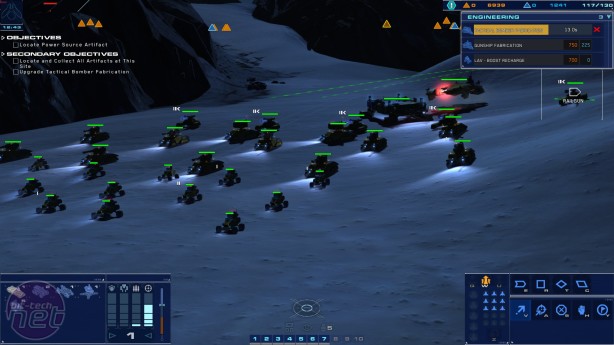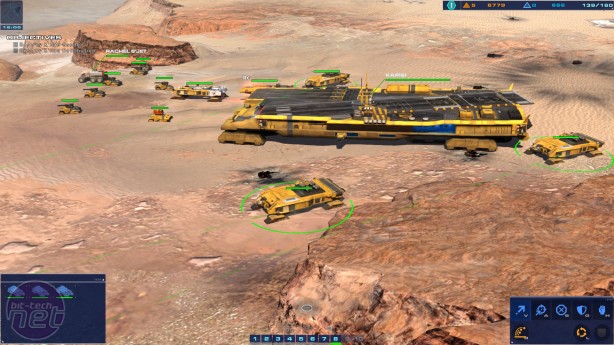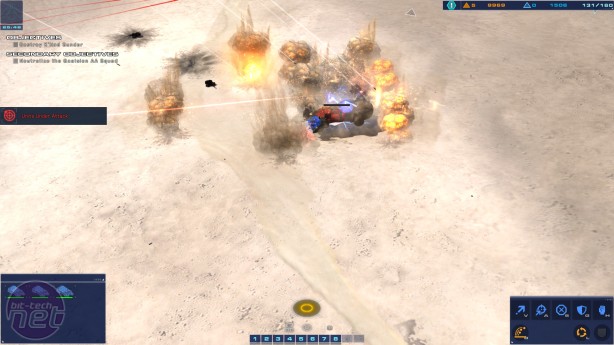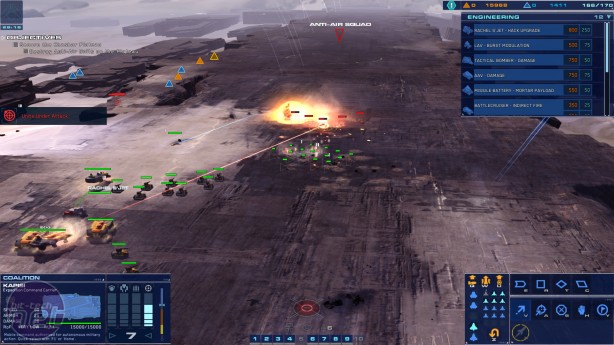Homeworld: Deserts of Kharak Review
January 21, 2016 | 08:58
Companies: #blackbird-interactive #gearbox-software

While the basic building blocks are very similar to Homeworld, the terrestrial setting results in more nuanced tactical options. Situating your units on higher terrain causes additional damage, for example. Units also have much greater defined strengths and weaknesses. Railguns, for example, are powerful, long range weapons. But their slow rate of fire makes them susceptible to attack from LAVs. Deserts of Kharak also introduces aerial units that can be deployed in squadrons for fast-response airstrike sorties. These are fantastic for dealing with an unanticipated flanking manoeuvre, but they're extremely weak to AA units.
Overall, Deserts of Kharak has a greater tactical layering to it than the original Homeworld. It's also just as spectacular. The games has a powerful sense of scale, and the detail on every unit, from the tracks they make on the sand, to the little smouldering wrecks they leave behind when destroyed, is splendid. By the end of a battle, the glistening sands are stained with dozens of tiny specks. Some of the more powerful abilities are incredible to behold. Artillery cruisers, for instance, come with a devastating "ground bombardment" ability that obliterates anything of sub-cruiser size. Even more formidable weaponry becomes available later on, but I'll leave those for you to discover yourself.
But what really makes Deserts of Kharak so arresting is the structuring and pacing of the campaign. Despite being set in a desert, each mission is both visually and conceptually distinct. One involves defending a vast plateau of black rock as you await a much-needed supply drop. In another, you must defend an allied carrier from a distance, using aerial and artillery attacks across a yawning chasm. Deserts of Kharak seldom lets you sit back and stockpile resources, there's always some obstacle or looming threat, and there's often a mid-mission twist that tests your resolve to the limit. Between missions, you're updated on your progress across the desert through elegant mid-mission cutscenes. Superbly acted and animated, these really aid to strengthen Kharak's sense of place, showing the obstacles that lie ahead and detailing the broader strategies to overcome them.
The way Deserts of Kharak adopts and distils all the strongest aspects of Homeworld is wonderful for the most part. But I do wonder whether it is too much a slave to tradition, and doesn't innovate as much as it could. Certainly, the "Shipbreaking" theme that runs through the game is woefully undercooked as a mechanic. It basically amounts to an occasional extra step in resource collection, where you must surround a chunk of derelict spacecraft with explosives and detonate them, revealing the juicy innards like you're peeling the world's toughest orange. And even this only serves to slightly inhibit the flow of an otherwise fantastically streamlined game.
I really would have liked to see the developers take this idea further, with warring factions gradually stripping down huge metal hulks half-buried in the desert, fighting over the scraps like hungry wolves, using the decaying wreckage to lay traps and ambushes. I suspect the developers initially had thoughts along the same lines, but the design was trimmed down because it conflicted with the needs of a canonical Homeworld game. I can't say whether this ultimately makes for a better or worse experience, but it certainly makes for a less adventurous one, and that's a shame.
If I had another complaint, I would say that it takes a smidge too long for the campaign to kick into high gear. Obviously, it's been quite some time since Homeworld, so it's understandable that many of its systems need to be reintroduced, alongside the smattering of ideas Deserts of Kharak adds on top. But it's only once aerial units come into play that the game fully opens up tactically. Prior to that, I worried it would boil down to another "build and swarm" RTS. This remains a viable tactic, if building and swarming is your thing, but aerial units and the more powerful abilities also mean it can be effectively countered.
Away from the Campaign, Deserts of Kharak offers both multiplayer and skirmish modes, where you can take on the AI or a human, scavenging resources, collecting artefacts and ultimately attempting to destroy your opponent's carrier. These games can include up to eight players for truly massive-scale vehicular conflict. Aside from letting you stretch your tactical legs by playing against a human, however, these modes offer little that's different from the standard campaign.
But that's fine. Homeworld was always about the single-player, the trials and tribulations of the Mothership as it journeyed across the galaxy. Deserts of Kharak lives up to the pioneering spirit of its predecessor, although I don't think it exceeds it in any particular way, which after sixteen years is a teeny, tiny bit disappointing. Nevertheless, as an RTS, it is superbly presented, thunderously entertaining, and just different enough to make it feel fresh.
Overall, Deserts of Kharak has a greater tactical layering to it than the original Homeworld. It's also just as spectacular. The games has a powerful sense of scale, and the detail on every unit, from the tracks they make on the sand, to the little smouldering wrecks they leave behind when destroyed, is splendid. By the end of a battle, the glistening sands are stained with dozens of tiny specks. Some of the more powerful abilities are incredible to behold. Artillery cruisers, for instance, come with a devastating "ground bombardment" ability that obliterates anything of sub-cruiser size. Even more formidable weaponry becomes available later on, but I'll leave those for you to discover yourself.
But what really makes Deserts of Kharak so arresting is the structuring and pacing of the campaign. Despite being set in a desert, each mission is both visually and conceptually distinct. One involves defending a vast plateau of black rock as you await a much-needed supply drop. In another, you must defend an allied carrier from a distance, using aerial and artillery attacks across a yawning chasm. Deserts of Kharak seldom lets you sit back and stockpile resources, there's always some obstacle or looming threat, and there's often a mid-mission twist that tests your resolve to the limit. Between missions, you're updated on your progress across the desert through elegant mid-mission cutscenes. Superbly acted and animated, these really aid to strengthen Kharak's sense of place, showing the obstacles that lie ahead and detailing the broader strategies to overcome them.
The way Deserts of Kharak adopts and distils all the strongest aspects of Homeworld is wonderful for the most part. But I do wonder whether it is too much a slave to tradition, and doesn't innovate as much as it could. Certainly, the "Shipbreaking" theme that runs through the game is woefully undercooked as a mechanic. It basically amounts to an occasional extra step in resource collection, where you must surround a chunk of derelict spacecraft with explosives and detonate them, revealing the juicy innards like you're peeling the world's toughest orange. And even this only serves to slightly inhibit the flow of an otherwise fantastically streamlined game.
I really would have liked to see the developers take this idea further, with warring factions gradually stripping down huge metal hulks half-buried in the desert, fighting over the scraps like hungry wolves, using the decaying wreckage to lay traps and ambushes. I suspect the developers initially had thoughts along the same lines, but the design was trimmed down because it conflicted with the needs of a canonical Homeworld game. I can't say whether this ultimately makes for a better or worse experience, but it certainly makes for a less adventurous one, and that's a shame.
If I had another complaint, I would say that it takes a smidge too long for the campaign to kick into high gear. Obviously, it's been quite some time since Homeworld, so it's understandable that many of its systems need to be reintroduced, alongside the smattering of ideas Deserts of Kharak adds on top. But it's only once aerial units come into play that the game fully opens up tactically. Prior to that, I worried it would boil down to another "build and swarm" RTS. This remains a viable tactic, if building and swarming is your thing, but aerial units and the more powerful abilities also mean it can be effectively countered.
Away from the Campaign, Deserts of Kharak offers both multiplayer and skirmish modes, where you can take on the AI or a human, scavenging resources, collecting artefacts and ultimately attempting to destroy your opponent's carrier. These games can include up to eight players for truly massive-scale vehicular conflict. Aside from letting you stretch your tactical legs by playing against a human, however, these modes offer little that's different from the standard campaign.
But that's fine. Homeworld was always about the single-player, the trials and tribulations of the Mothership as it journeyed across the galaxy. Deserts of Kharak lives up to the pioneering spirit of its predecessor, although I don't think it exceeds it in any particular way, which after sixteen years is a teeny, tiny bit disappointing. Nevertheless, as an RTS, it is superbly presented, thunderously entertaining, and just different enough to make it feel fresh.


MSI MPG Velox 100R Chassis Review
October 14 2021 | 15:04













Want to comment? Please log in.